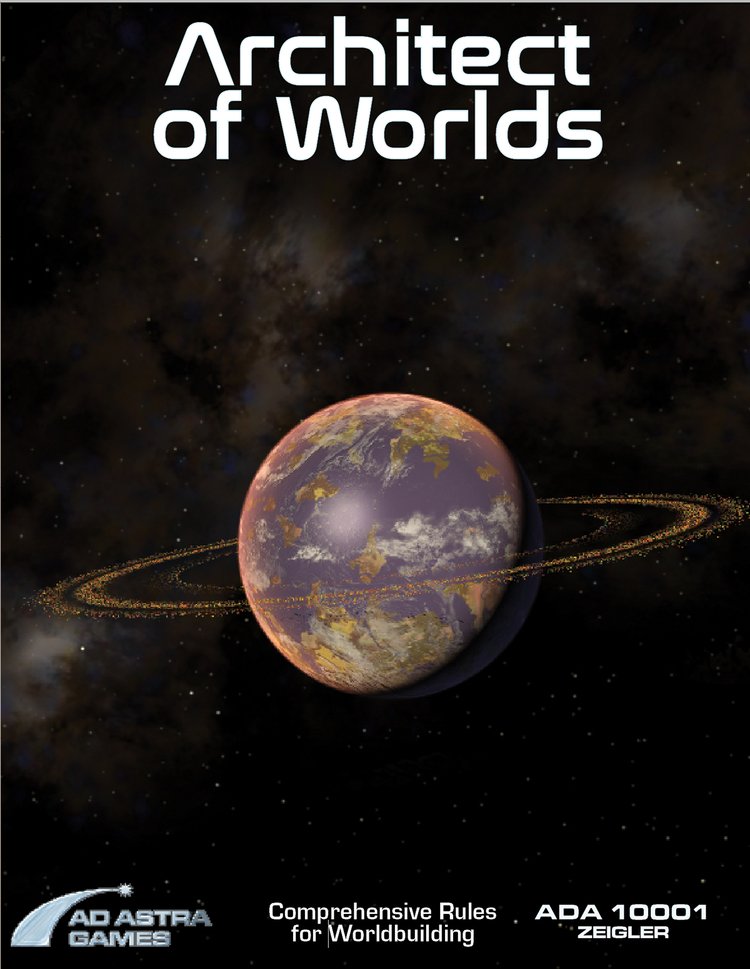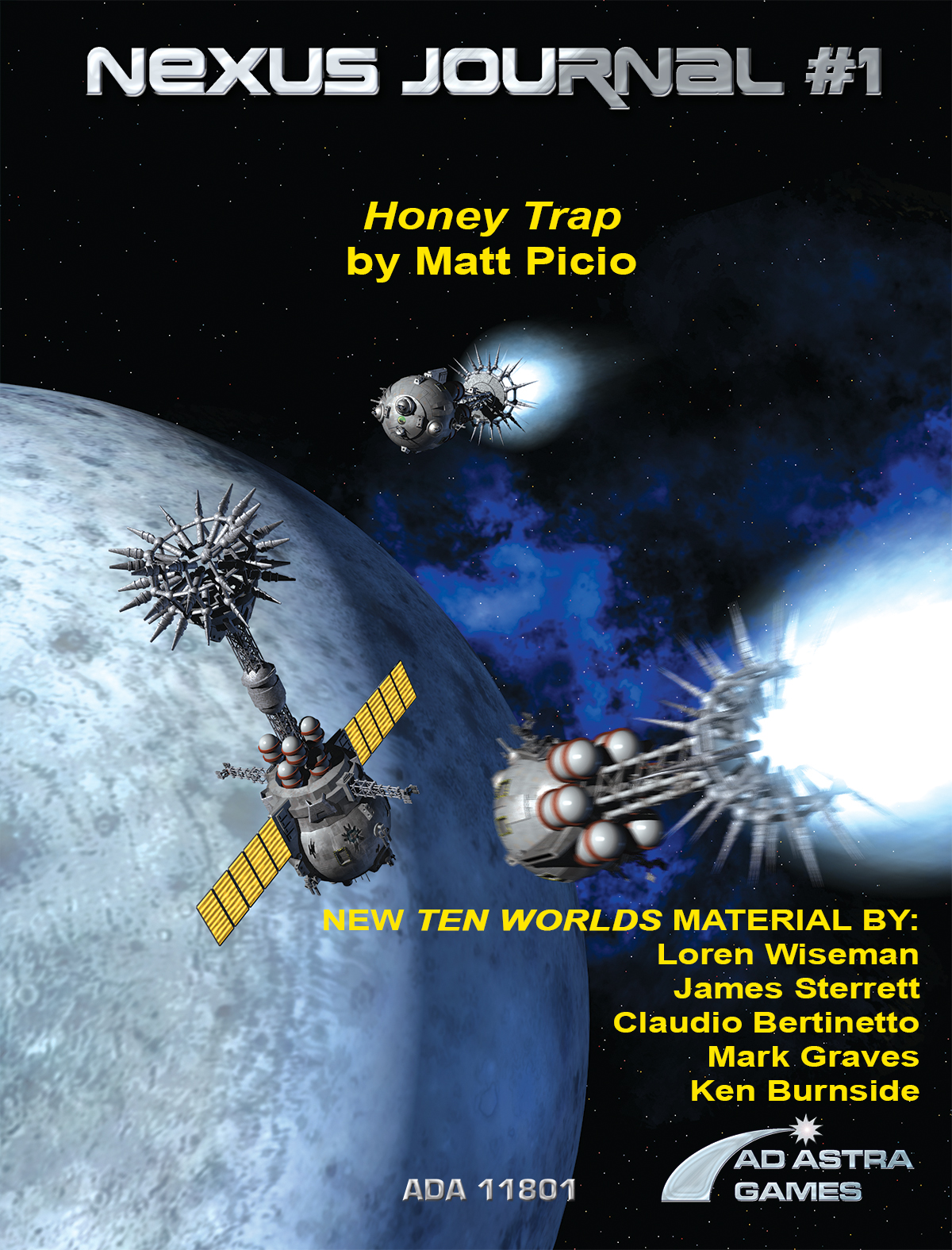 Architect of Worlds
Architect of Worlds
Comprehensive World Design for Interstellar Fiction
by Jon F. Zeigler
Edited by Ken Burnside
Ad Astra Games, LLC
ISBN 978-1-942726-32-6
$34.95
Print & Electronic Editions
Ad Astra Games is well-known for its publication of award-winning, scientifically accurate space games that feature real 3D vector movement, which, if you have even a smattering of physics under your belt, you will know is not the way spaceship maneuvering has been depicted in just about every film and television show featuring such things since that artillery shell fired from Florida took out the Moon’s eye.
On screen, ships bank, stop, turn on a dime, don’t conserve momentum and generally fail to take gravity and fuel consumption into account at all. (Gamer’s are entertaining themselves, not studying for an Astrogator’s license.)
 This, I can tell you, was a huge concern in the early days of space gaming, with numerous efforts (including my own) attempting to bring a greater degree of verisimilitude to the action, in generally 2D ways, though some tabletop efforts did introduce a third dimension (that space above and below the hex map).
This, I can tell you, was a huge concern in the early days of space gaming, with numerous efforts (including my own) attempting to bring a greater degree of verisimilitude to the action, in generally 2D ways, though some tabletop efforts did introduce a third dimension (that space above and below the hex map).
One early attempt at such things was a game from the much storied (and lamented) SPI game company – Star Force. In order to calculate your FTL ship’s movements, you had to do math – and a fair amount of it. (And most folks didn’t have calculators with special functions back then either.) While instructive, that tended to slow things down, especially if not all of the players were math nerds.
But that was all taken care of by some long and brilliant design work by Ken Burnside of Ad Astra Games, and there was much rejoicing.
Now Ken is publishing (and feverishly editing as I write this review) a book tackling another subject of deep interest to space gamers – creating realistic star systems, all based on the latest science and discoveries, with the soon to be released Architect of Worlds by Jon F. Zeigler.
 Zeigler has a background in both tabletop design and mathematics (which is very quickly apparent as soon as you crack the covers of AoW). He’s done freelance work for Steve Jackson Games (as did I) and has been a mathematician and software engineer for the US Government. (Learn more on his website – he writes Science Fiction too – apparently a trifecta winner!)
Zeigler has a background in both tabletop design and mathematics (which is very quickly apparent as soon as you crack the covers of AoW). He’s done freelance work for Steve Jackson Games (as did I) and has been a mathematician and software engineer for the US Government. (Learn more on his website – he writes Science Fiction too – apparently a trifecta winner!)
Here’s the thing though: Architect of Worlds is not just a game supplement with a bunch of exciting, descriptive paragraphs filled with SF buzzwords that lead you to a series of 2D10 tables – roll for star type, roll for number of planets, roll for atmosphere, pick a quirky name, viola – Homeworld!.
Nope.
Decidedly nope.
This book is a comprehensive, well-designed journey through the actual process of stellar evolution. It walks you through planetary formation, the kind of atmospheres that would result, and all the other detail goes into the formation of a real world, in a real solar system, centered on a real sun, that formed according to the currently known real processes. That walk-through? It’s done in a conversational voice, even as each step of the process shows the actual formulas used. Some of the audience for this book won’t have used algebra in a couple of decades, and Zeigler takes his job of being your guide through formulas seriously.
It delivers the process of performing all of the background work in a step-by-step approach that mirrors the actual process in its order and does so in a light, easily comprehensible way, even for folks who still wrestle with algebra.
Here’s the steps from just one chapter – Designing Planetary Systems
Step 9: Protoplanetary Disk
Step 10: Disk Instability
Step 11: Core Accretion
Step 12: Oligarchic Collision (no, not a car accident between Musk and Bezos)
Step 13: Planetary Orbital Radii
Step 14: Planetary Mass
Step 15: Orbital Eccentricity
Step 16: Physical Parameters
Step 17: Natural Satellites
(I hope this list of steps gives you some small indication of the amount of detail included here.)
As in the real world (galaxy? universe?), each step is dependent upon the calculations performed in previous steps, because that’s the way things actually work: you can’t have planets without there first being stellar formation (covered in Steps 1-8), because the kind of star you end up with greatly influences the processes that follow.
 It is obvious that a lot of hard work went into figuring out how to arrange all of these materials and fashion a methodology that is easily understood and straight-forward in walking a reader through the process. Each step offers an explanation of what the step addresses, the procedure to accomplish the step – with variations that are specifically game oriented (like alternate methods for placing an Earthlike planet where desired) included – followed by examples that illustrate how to use the procedure and concluding with notes that provide citations for the reference materials used that underpin that step.
It is obvious that a lot of hard work went into figuring out how to arrange all of these materials and fashion a methodology that is easily understood and straight-forward in walking a reader through the process. Each step offers an explanation of what the step addresses, the procedure to accomplish the step – with variations that are specifically game oriented (like alternate methods for placing an Earthlike planet where desired) included – followed by examples that illustrate how to use the procedure and concluding with notes that provide citations for the reference materials used that underpin that step.
All of the tables needed and their use are included in the appropriate step as well.
This is a fantastic game aid (whose layout, incidentally, kind of mirrors that of a very popular SF game series – Traveler; players of that game will find it a comfortable fit) – but that’s not all it is.
I fully expect that this volume will become a standard reference work for science fiction authors who value scientific accuracy and realism in their work. I can think of several right off the top of my head who have probably already pre-ordered it – C. J. Cherryh, Larry Niven, Allen Steele – and it wouldn’t surprise me to find this book mentioned in future acknowledgements of Hard SF/Space Opera works. (In fact, I fully expect that future “author photos” will show a copy of this book on their shelves in the background.)
I’ll also note that Jon Zeigler has done an excellent job with the layout of this volume, it’s light, appealing and, if you can believe it about a book with tables and mathematical formulae, a page turner!
Architect of Worlds (I like the reference to the Fleet of Worlds series by Niven and Lerner) Comprehensive World Design for Interstellar Fiction is highly recommended for game designers and players of the SF variety AND highly recommended for authors of science fiction fare who like to get it right.
To preorder your copy, click here.











1 Comment